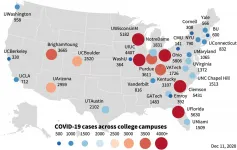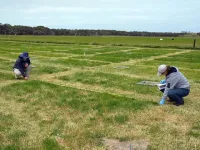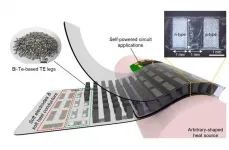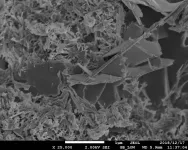(Press-News.org) College campuses are at risk of becoming COVID-19 superspreaders for their entire county, according to a new vast study which shows the striking danger of the first two weeks of school in particular.
Looking at 30 campuses across the nation with the highest amount of reported cases, experts saw that over half of the institutions had spikes - at their peak - which were well above 1,000 coronavirus cases per 100,000 people per week within the first two weeks of class.
In some colleges, one in five students had been infected with the virus by the end of the fall term. Four institutions had over 5,000 cases.
In 17 of the campuses monitored, a new computer model developed by scientists at Stanford University shows outbreaks translated directly into peaks of infection within their home counties.
Out today, the team's research - published in the peer-reviewed journal Computer Methods in Biomechanics and Biomedical Engineering - crucially shows, however, that tight outbreak management, for example the immediate transition from in person to all online learning, can reduce the peaks within about two weeks.
Lead author Hannah Lu, from Stanford's Energy Resources Engineering program, says the incidence levels of 1,000 cases per 100,000 people per week - when compared to the first and second waves of the pandemic with peak incidences of 70 to 150 - means colleges are at real risk of developing an extreme incidence of COVID-19.
"Policy makers often use an incidence of 50 COVID-19 cases per 100,000 people per week as a threshold for high risk counties, states, or countries. All 30 institutions in our study exceeded this value, three even by two orders of that magnitude," she states.
"The number of students who had become infected just throughout the fall is more than twice of the national average since the beginning of the outbreak of 5.3%, with 17.3 million reported cases at a population of 328.2 million.
"At the University of Notre Dame, for instance, all 12,607 students were tested before the beginning of class and only nine had tested positive. Less than two weeks into the term, the seven-day incidence was 3083, with a reproduction number R0 of 3.29.
"However," she adds, "with around 90 reported deaths nationwide, mainly college employees and not students, the campus-related death rate of 0.02% remains well below the average death rate of COVID-19."
Members of the research team used advanced modelling, which assesses the real-time epidemiology of the COVID-19 outbreak using an SEIR (susceptible, exposed, infectious, and recovered) model to map how the disease spread across the campuses.
They drew COVID-19 case reports from 30 publicly available college dashboards across the United States throughout the fall of 2020. These institutions were either teaching in person, online or a hybrid of both. They selected colleges for which case numbers are reported on a daily basis and the total cumulative case number exceeded 100.
During this time window, the nationwide number of new cases had dropped below 50,000 per day.
A limitation of this study is that the true on-campus student population was often unreported and had to be approximated by the total fall quarter enrollment. "This likely underestimates of the real maximum incidence and the fraction of on-campus students that have been affected by the virus," the authors state.
Senior author, Ellen Kuhl, adds: "Strikingly, these local campus outbreaks rapidly spread across the entire county and triggered a peak in new infections in neighbouring communities in more than half of the cases.
"It is becoming increasingly clear that these initial college outbreaks are unrelated to the national outbreak dynamics. Instead, they are independent local events driven by campus reopening and inviting students back to campus.
"Our results confirm the widespread fear in early fall that colleges could become the new hot spots of COVID-19 transmission. But, at the same time, college administrators should be applauded for their rapid responses to successfully manage local outbreaks."
All reported campuses pursued regular surveillance testing, weekly or even twice per week, combined with aggressive test-trace-isolate strategies.
"The majority of colleges and universities were able to rapidly manage their outbreaks and suppress campus-wide infections, while the neighbouring communities were less successful in controlling the spread of the virus. As a result, for most institutions, the outbreak dynamics remained manageable throughout the entire fall of 2020 with narrow spikes of less than 300 cases per day," Lu states.
The team believes that this methodology, in combination with continuing online learning, is the best way to prevent college sites from becoming the major hub of the disease.
"Our study suggests that tight test-trace-isolate strategies, flexible transition to online instruction, and-most importantly-compliance with local regulations will be critical to ensure a safe campus reopening after the winter break," she added.
Professor Kuhl concludes: "We anticipate that the most important aspect upon campus reopening within the coming weeks will be the human factor. Unfortunately, the fall term has shown that the best of all strategies can become meaningless if people do not follow the recommendations."
INFORMATION:
A detailed description of how ovarian cancer cells adapt to survive and proliferate in the peritoneal cavity has been published in Frontiers in Oncology. Researchers show that structures inside the cells change as the disease progresses from benign to malignant, helping the cells to grow in an otherwise hostile environment of low nutrients and oxygen. Understanding how these cellular adaptations are regulated could herald new targeted treatment options against the fifth-leading cause of cancer-related deaths in women.
"Our study compared the structures inside cells representing different stages of ovarian cancer, including after aggregation, which enhances their survival," says Eva Schmelz, a Professor and Scientific Director at Virginia Tech University, USA, who led this research. "We found ...
The remote learning experience of parents who had their children at home in Spring 2020, as schools across the US closed during the United States' COVID-19 lockdown, was more positive than widely believed.
That is the suggestion from a new study published in the Journal of School Choice, which looked at the experience of a nationally representative sample of 1,700 parents stretching right across America.
On average only 44% of parents reported the online learning program required too much of parents, while 38% of parents said it was difficult for them to manage the online provisions.
However, worryingly, most parents (63%) believed remote learning caused their child to fall behind.
While the study focused ...
Yale researchers have devised a way to peer into the brains of two people simultaneously while are engaged in discussion. What they found will not surprise anyone who has found themselves arguing about politics or social issues.
When two people agree, their brains exhibit a calm synchronicity of activity focused on sensory areas of the brain. When they disagree, however, many other regions of the brain involved in higher cognitive functions become mobilized as each individual combats the other's argument, a Yale-led research team reports Jan. 13 in the journal Frontiers of Human Neuroscience.
"Our entire brain ...
A loss of biodiversity and accelerating climate change in the coming decades coupled with ignorance and inaction is threatening the survival of all species, including our very own, according to the experts from institutions including Stanford University, UCLA, and Flinders University.
The researchers state that world leaders need a 'cold shower' regarding the state of our environment, both to plan and act to avoid a ghastly future.
Lead author Professor Corey Bradshaw of Flinders University in Australia says he and his colleagues have summarised the state of the natural world in stark form to help clarify the gravity of the human predicament.
"Humanity is causing a ...
Tsukuba, Japan - Work causes so much stress that it's become a global public health issue. Stress's impact on mental and physical health can also hurt productivity and result in economic loss. A new study now finds that working people who regularly take walks in forests or greenspaces may have higher stress-coping abilities.
In a study published in Public Health in Practice, researchers led by Professor Shinichiro Sasahara at the University of Tsukuba analyzed workers' "sense of coherence" (SOC) scores, demographic attributes, and their forest/greenspace walking habits. SOC comprises the triad of meaningfulness (finding a sense of meaning in life), comprehensibility (recognizing and understanding stress), and ...
CLEVELAND, Ohio (Jan. 13, 2021)--If you're a bit more forgetful or having more difficulty processing complex concepts than in the past, the problem may be your menopause stage. A new study claims that menopause stage is a key determinant of cognition and, contrary to previous studies, shows that certain cognitive declines may continue into the postmenopause period. Study results are published online today in Menopause, the journal of The North American Menopause Society (NAMS).
It's commonly assumed that people's memories decline with age, as does their ability to learn new things and grasp challenging concepts. ...
The ability of our skin to protect us from chemicals is something we inherit. Some people are less well-protected which could imply an increased risk of being afflicted by skin disease or cancer. A new study from Karolinska Institutet in Sweden that has been published in Environmental Health Perspectives shows how the rate of uptake of common chemicals is faster in people with a genetically weakened skin barrier.
We are continually exposed to chemicals from many different sources, for example, food, hygiene products, cosmetics and textiles. Many people are also exposed to chemicals at their place of work which can constitute a work environment problem.
The protein filaggrin is important for the structure and moisture balance of the skin, properties that affect ...
January 13, 2021 - The element nitrogen is a double-edged sword. It is essential for growing plants and feeding people, but it is also a leading cause of pollution across the world. Only by using nitrogen more sustainably can the positive and harmful effects of nitrogen be balanced.
Xia (Emma) Liang, a member of the American Society of Agronomy, studies nitrogen loss during food production.
Liang and her team created a framework that accurately measures nitrogen loss across a wide variety of crops and food products. She recently presented their research at the virtual 2020 ASA-CSSA-SSSA Annual Meeting.
"This framework can capture the environmental impacts and societal costs of nitrogen ...
A thermoelectric device is an energy conversion device that utilizes the voltage generated by the temperature difference between both ends of a material; it is capable of converting heat energy, such as waste heat from industrial sites, into electricity that can be used in daily life. Existing thermoelectric devices are rigid because they are composed of hard metal-based electrodes and semiconductors, hindering the full absorption of heat sources from uneven surfaces. Therefore, recent studies were actively conducted on the development of flexible thermoelectric devices capable of generating energy in close contact with various heat sources such as human skins and hot water pipes.
The Korea Institute of Science and Technology (KIST) announced ...
A rare mineral that has allowed Roman concrete marine barriers to survive for more than 2,000 years has been found in the thick concrete walls of a decommissioned nuclear power plant in Japan. The formation of aluminous tobermorite increased the strength of the walls more than three times their design strength, Nagoya University researchers and colleagues report in the journal Materials and Design. The finding could help scientists develop stronger and more eco-friendly concrete.
"We found that cement hydrates and rock-forming minerals reacted in a way similar to what ...




